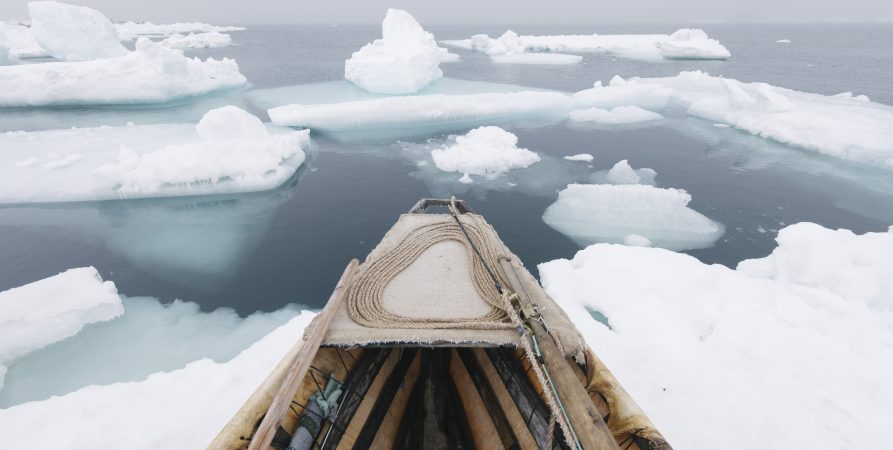Hunting snow goggles or maskette
Life Story
Snow goggles play an essential part in Arctic lives during spring time when the high sun reflects on the spring ice. Snow goggles, however, were also part of funerary rites and perhaps for spiritual enhancement. These exquisite Iputiak snow goggles with round eye holes, carved from walrus ivory between 200 and 400 AD, illustrate the long presence of snow goggles in the Arctic. [1]
William W. Fitzhugh, a respected archaeologist at the Smithsonian Institute, writes about this object:
These goggles may have been used to cover the eyes as part of funerary or hunting ritual as their large round holes would have been of little use for protecting the eyes from snow blindness. If for ritual or burial, the eye-holes would probably have been fitted with plugs of wood, jet, and other material to “block” the deceased’s vision or keep dangerous spirits from re-animating the corporeal remains. [2]
Within the well-preserved Ipiutak graves similar goggles, or maskettes, have been found. [3] Ipiutak have been renowned for their elaborated funerary practices. The deceased Ipiutak, some of them wearing exceptionally intricate so-called death masks, [4] would be buried in a driftwood box tomb with their finest possessions. [5] Within Inupiat oral history about the Blind Man and the Loon, as told in Utqiaġvik, snow goggles are also related to the hunter’s eyesight. In an abbreviated version, a resentful grandmother burns the wooden snow goggles of her son who is a successful hunter. Subsequently, the son loses his eyesight only to get it restored by Loon. [6] The connection between birds and especially the loon, aŋatquq (spiritual expert or shaman), and vision might provide further clues about these snow goggles. [7] Ipiutak graves include a number of loon-related motifs and likely articulates the spiritual significance and power of loons as mediators between worlds. [8]
These snow goggles, however, might rather be related to owls as curator Amber Lincoln suggests. [9] The circular rather large holes around the eyes are encircled and decorated with small dots. A second circle encapsulates the first circle and is engraved with miniscule lines. A third dual circle is concluding the circular lines around the eyes. The top and bottom near the nose are a set of elaborative teardrop-shaped engravings. On top of the goggles, or maskette, further has several dots. The detailed engravings and various designs are extra-ordinary and we can only admire the skills the carver had and the time it took to carve this object. We might also contemplate what the wearer of these snow goggles, or maskette, envisioned as aŋatquq or hunter, or indeed, how this mask helped with the deceased’s travels to the Other World?
Peter Loovers, March 2022
[1] Mason, Owen K. 2020. Focusing on the Coast. In Arctic: culture and climate. Amber Lincoln, Jago Cooper, and Jan Peter Laurens Loovers (Eds.). Pp. 187-196. London: Thames & Hudson in collaboration with The British Museum. p. 190, 195. P. 195
[2] Fitzhugh, William W. 2009. Eagles, Beasts, and Gods: Art of the Old Bering Sea Hunting Complex. In Gifts from the Ancestors: Ancient Ivories of the Bering Strait. William W. Fitzhugh, Julie Hollowell, and Aron L. Crowell Princeton: Princeton University Art Museum P.162-189. 166
[3] Larsen, Helge and Froelich Rainey. 1947. Ipiutak and the Arctic Whale Hunting Culture. Anthropological Papers of the American Museum of National Histor, Volume 42. New York: Published by the order of the Trustees of the American Museum of Natural History. P. 113, Plate 24, number 14; see also Tony Allan, Michael Kerrigan, and Charles Phillips, Spirits of the Snow: Arctic Myth, (Amsterdam: Time-Life Books, 2001), p. 7.
[4] Mason, Owen K. 2020. Focusing on the Coast. In Arctic: culture and climate. Amber Lincoln, Jago Cooper, and Jan Peter Laurens Loovers (Eds.). Pp. 187-196. London: Thames & Hudson in collaboration with The British Museum. p. 190, 195. P. 198
[5] Froelich G. Rainey, ‘A New Form of Culture on the Arctic Coast’, Proceedings of the National Academy of Sciences, 27(1941), pp. 141-144 (p. 142)
[6] Phyllis Morrow and Toby Alice Volkman, ‘The Loon with the Ivory Eyes: A Study in Symbolic Archaeology’, The Journal of American Folklore, 88 (1975), pp. 153-150 (p. 147); see also Erica Hill, Humans, Birds and Burial Practices at Ipiutak, Alaska: Perspectivism in the Western Arctic, Environmental Archaeology, 24 (2019)
[7] Erica Hill, Humans, Birds and Burial Practices at Ipiutak, Alaska: Perspectivism in the Western Arctic, Environmental Archaeology, 24 (2019)
[8] Lauryn C. Justice and Daniel H. Temple, ‘Bioarchaeological Evidence for Social Maturation in the Mortuary Ritual of Ipiutak and Tigara Hunter-Gatherers: Lifespan Perspectives on the Emergence of Personhood at Point Hope, Alaska’, American Antiquity, 84 (2019), pp. 234-251
[9] Amber Lincoln in ‘In from the Cold: Five Sainsbury Centre Treasures at the British’, (2020), https://www.sainsburycentre.ac.uk/stories/in-from-the-cold/ [accessed 06 December 2021]
Provenance
Purchased by the Sainsbury Centre, University of East Anglia from Miriam Shiell Fine Art, Toronto, in 1999 out of funds provided by Robert and Lisa Sainsbury.
On display
Title/Description: Hunting snow goggles or maskette
Object Type: Mask
Materials: Walrus ivory
Technique: Carving, Drilling, engraving
Measurements: h. 61 x w. 120 x d. 25 mm
Accession Number: 1159
Historic Period: early Ipiutak (200-400 AD)
Production Place: Alaska, North America, Seward Peninsula, The Americas
Cultural Group: Ipiutak
Credit Line: Purchased with support from Robert and Lisa Sainsbury, 1999
In from the Cold: Five Sainsbury Centre Treasures at the British Museum
Objects from the Centre’s collection offer snapshots of life in the Arctic
Continue reading






